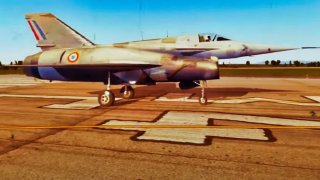Nord 1500 Griffon: The Fighter That Broke All the Rules and Speed Records
The delta-winged Nord 1500 Griffon made her maiden flight on Sept. 20, 1955. Only two airframes were built, courtesy of the state-owned Nord Aviation, a company founded in the previous year that would famously develop the Exocet anti-ship missile before going defunct in 1970.
Anyone who has traveled on the Eurostar train between London's St. Pancras International Station and Paris will be familiar with the French capital’s Gare du Nord, the “train station of the North” and the busiest train depot in all of Europe. Well, if the French-made Nord 1500 Griffon interceptor had ever made it past the experimental level and gone into full-time production, the Griffon might have been dubbed la gardienne du nord – “the guardian of the north." Though the plane did not make it beyond the prototype phase, her history is still worth exploring, so let's take a closer look at the Nord 1500 Griffon.
The Nord 1500 Griffon Gives It a Go
The delta-winged Nord 1500 Griffon made her maiden flight on Sept. 20, 1955. Only two airframes were built, courtesy of the state-owned Nord Aviation, a company founded in the previous year that would famously develop the Exocet anti-ship missile before going defunct in 1970.
Directly descended from Nord's Gerfaut (Gyrfalcon), the Griffon was a Mach-2 successor. The plane derived its speed and power from a dual propulsion turbojet-ramjet configuration — the former was used for takeoff, and the latter kicked in at supersonic speed.
For the benefit of our readers unfamiliar with the ramjet concept, NASA's Glenn Research Center provides a detailed explanation:
"In a ramjet, the high pressure is produced by "ramming" external air into the combustor using the forward speed of the vehicle. The external air that is brought into the propulsion system becomes the working fluid, much like a turbojet engine. In a turbojet engine, the high pressure in the combustor is generated by a piece of machinery called a compressor. But there are no compressors in a ramjet. Therefore, ramjets are lighter and simpler than a turbojet. Ramjets produce thrust only when the vehicle is already moving; ramjets cannot produce thrust when the engine is stationary or static. Since a ramjet cannot produce static thrust, some other propulsion system must be used to accelerate the vehicle to a speed where the ramjet begins to produce thrust. The higher the speed of the vehicle, the better a ramjet works until aerodynamic losses become a dominant factor."
In some ways, the Nord 1500’s ramjet was as good as advertised. The second prototype plane, Griffon II, hit a max airspeed of Mach 2.19 (2,320 kilometers per hour), thus setting a world record on Oct. 5, 1959, for a closed-circuit course. By contrast, Griffon I was only able to reach Mach 1.3 (1,605kph).
The man at the controls during the Nord 1500 Griffon II’s record-setting flight was test pilot André Turcat, who would go on to make more aviation history 15 years later when he became the first person to fly the Concorde. (On Dec. 15, 1959, Turcat's record would be broken by the U.S. Air Force’s Joe Rogers while flying an F-106 Delta Dart. That record still stands, 62 years later, as the fastest ever flight in a single-engine fighter.)
Sacre Bleu! C'est Dommage
Despite the promise it showed, all was not well with the Griffon. For one thing, the airframe suffered from high heat sensitivity due to the lack of temperature-resistant materials in the plane's Duralumin alloy skin. In addition, the ramjet was found to be problematic at mid-range speeds, and its exhaust temperature often damaged the tailpipe.
What's more, there was the issue of dollars and sense, or more accurately, francs and centimes. The Dassault Mirage III proved to be a simpler and less expensive warbird while still offering a high standard of performance. With all that in mind, Griffon II made her final flight on June 5, 1961.
The Nord 1500 Griffon is now on display at the French Air and Space Museum (Musée de l'Air et de l'Espace) at Le Bourget near Paris.
About the Author
Christian D. Orr is a former Air Force officer, Federal law enforcement officer, and private military contractor (with assignments worked in Iraq, the United Arab Emirates, Kosovo, Japan, Germany, and the Pentagon). Chris holds a B.A. in International Relations from the University of Southern California (USC) and an M.A. in Intelligence Studies (concentration in Terrorism Studies) from American Military University (AMU). He has also been published in The Daily Torch and The Journal of Intelligence and Cyber Security.Last but not least, he is a Companion of the Order of the Naval Order of the United States (NOUS).


